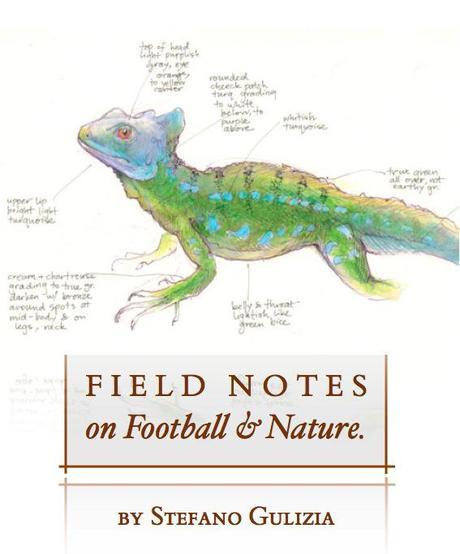
{For my part (. . .), I look at the natural geological record, as a history of the world imperfectly kept, and written in a changing dialect; of this history we possess the last volume alone, relating only to two or three countries. —Darwin, On the Origin of Species}
‹22 September. Discussions of Fernando Torres’ work may be locked in a predictable debate about the way enormous reserves of money promote a transformation toward more complex forms of footballing life, while fueling occasional catastrophes, but it is, as a few writers fairly noted, an intellectual tour de force filled with meatier arguments of great interest. Catastrophists and speculators opposed to field evidence insist on vectors of brilliant or abysmal performances, struggling to come to terms with aspects of uniformity—of soccer as a world in constant motion, but always the same in substance and state, changing bit by bit in a stately dance toward perfection. The real debate, so lost at our peril in the success of Abramovich’s (or any other oligarch’s) bombast, is the grandest battle ever fought between two contrasting visions of the traditional striker as a goal-poacher.
I do not gloat in this analysis to “show up” Torres as less empirical or field-oriented than his catastrophists opponents. I find no particular virtue in empirical literalism and generally support a balance of fact and theory. I just find it deliciously ironic that chalkboard history touts Fernando’s failure at Chelsea as the triumph of Villas-Boas’ meticulous fieldwork (as seen with Porto), while catastrophists would consider him the true champion of a kind of geological data, the Spaniard being unfit for the Premier League, that is read as directly seen. Torres himself, by contrast, urged the theory that, in order to be successful at imposing his style of playing, he’d need soccer abruptness. To uphold his ideal of goal uniformity, in the face of this remarkable admission, Fernando is using an argument that resonates with discussions about the prominence of ‘Time’s cycle’ versus ‘Time’s arrow’ in natural history. In similar terms, the great scientist Charles Lyell admits the literal appearance of catastrophe as predominant in geology:
The marks of former convulsions on every part of the surface of our planet are obvious and striking. . . If these appearances are once recognized, it seems natural that the mind should come to the conclusion, not only of mighty changes in past ages, but of alternate periods of repose and disorder—of repose, when the fossil animals lived, grew, and multiplied—of disorder, when the strata wherein they were buried became transferred from the sea to the interior of continents, and entered into high mountain chains (Principles of Geology, I, 7).
An alternation of phases—of repose, when the striker drifts out of the game and gives the impression of apparent uniformity—of disorder, when his effort at scoring speaks too loudly for discontinuity.

James Hutton's Geological Draft II
Read literally, then and now, both the geological and the soccer record is primarily a tale of abrupt transitions, at least in local areas. When environments are changing from terrestrial to marine, for instance, or when a team rapidly changes its shape after soaking the opponent’s pressure, the sediments typically indicate no sign of gradual yield. Faunal transitions are almost always abrupt, both from species to species and from biota to biota; even Barcelona’s style, which heavily relies on outlandish possession, ultimately promulgates a conversion, characteristically nervous, toward a method of catastrophism. (This produces, in fact, major mass extinctions of soccer’s history, of the kind in which dinosaurs have given way to the realm of mammals.) According to the theory of ‘punctuated equilibrium,’ developed by Niles Eldredge and Stephen Jay Gould in the 1970s, these transitions between species, as between, say, Barcelona’s defensive 4—3—3 to their signature 3—4—3 attacking shape, are better seen not as artifacts or imperfect fossil records, as in the chalkboard tradition, but rather as an accurate reflection of the workings of evolution.
Can rare bursts of evolutionary or tactical changes coexist with extended periods of what in history would be homeostasis and on the soccer pitch, at best, would be stagnation? Is Fernando’s argument, when he laments the absence of the bursting runs routinely provided from box-to-box midfielders, completely self-serving? Or is he, in a sense, a smoother interpreter of phyletic gradualism in football than people give him credit for? Apparently, in the light of Villas-Boas’ rhetorical brand, soccer abruptness should be seen as an impoverished degradation of the underlying uniformity in his tactical book—a posture earlier adopted by Charles Darwin for defending gradualism in fossil sequences.
Torres’ work is awash in water. There is a liquid substance, stretching from his eyes to the blue-cobalt of his jersey, that is silhouetting with distinguishing elegance his statuary, slightly androginous body: glimmers of faintly white pallor, smothered by sudden crashes of scarlet berry frozing on his cheeks. Of course, geological records are even more scanty and erratic in soccer, and, besides, there has been a complete turnover for Fernando Torres, from Spain to England, spaced a few years apart, from one recorded instance to the next—the illusory catastrophe that appears when continuity is sampled too sparsely. The future may hold further catastrophic occurences or some law of sporadic sedimentation. But there could be no doubt that Torres is bred in the restrictive captivity of Time’s arrow/Time’s cycle. A dream of rocks and caves, his nearest taxonomic proximity is to the first of the song-cycle Sea Pictures, set to music by Sir Edward Elgar:
Sea-birds are asleep,/ The world forgets to weep,/ Sea murmurs her soft slumber-song/ On the shadowy sand/ Of this elfin land;
Hush, Niño, soccer’s eternal child—like violins or tears are your slumbering (Chel)sea-sounds. ♦
Previous: Mazzarri’s Geology.


